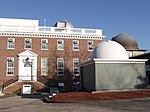Edward Dodge House (Cambridge, Massachusetts)
Cambridge, Massachusetts Registered Historic Place stubsHouses completed in 1878Houses on the National Register of Historic Places in Cambridge, MassachusettsQueen Anne architecture in Massachusetts

The Edward Dodge House is a historic house at 70 Sparks Street in Cambridge, Massachusetts. The 2+1⁄2-story wood-frame house was built in 1878 to a design by Longfellow and Clark. It has asymmetrical massing typical of Queen Anne styling, and also has a style of half-timbering on its upper levels that was popular in England in the 1860s. The exterior surfaces have a variety of textures, create by different sheathing types, including vertical boards, wood paneling, and brick patternwork.The house was listed on the National Register of Historic Places in 1982.
Excerpt from the Wikipedia article Edward Dodge House (Cambridge, Massachusetts) (License: CC BY-SA 3.0, Authors, Images).Edward Dodge House (Cambridge, Massachusetts)
Sparks Street, Cambridge
Geographical coordinates (GPS) Address Nearby Places Show on map
Geographical coordinates (GPS)
| Latitude | Longitude |
|---|---|
| N 42.379722222222 ° | E -71.131388888889 ° |
Address
Sparks Street 72
02163 Cambridge
Massachusetts, United States
Open on Google Maps











